So do you want to learn how to ice skate backwards? Actually doing this may seem a little strange at first. If you’ve ever tried it, you may feel like you’re going to fall at any moment. Does this sound familiar?
Don’t worry, I’ve been through this too. It is all about balance and self-confidence. By the end of this guide, you’ll be gliding backwards on the rink like a pro. Are you ready? Let us understand it step by step.
Step 1: Feel comfortable moving forward first
Before even thinking about going backward, you need to feel strong skating forward. U.S. Figure skating recommends mastering forward skating techniques in order to create the balance needed for backward skating.
Quick tips:

- Feet should be shoulder width apart
- knees slightly bent
- Keep your weight between your legs, not too far forward or back.
Personal Story: When I first started learning to skate backwards, I spent a lot of time skating forwards to build confidence. It took a few weeks of regular practice, but by focusing on balance, I began to feel comfortable enough to move on to the next step.
Once you’re comfortable with that, we can start talking about skating backwards.
Step 2: Master the “Lemon” Technique
One of the fundamental moves for skating backwards is called the “lemon” or “C-cut.” It’s simple, helps build confidence, and is endorsed by professional skating coaches.
How to do the “lemon”:
- Start with your ankles together and toes pointing outward (like a “V”).
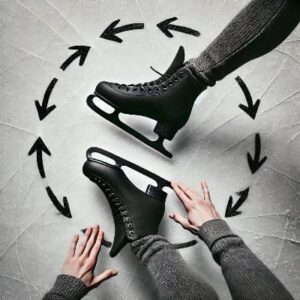
- Push your feet outward, then bring them back in.
- Repeat this motion. 3. Repeat this motion. You should start making small “C” shapes on the ice – like a lemon shape!
This technique may seem slow, but it has a strong foundation. Patrick Chan, a renowned Canadian figure skating coach, often emphasizes the importance of mastering this technique before moving on to more complex moves such as crossovers.
Step 3: Learn to Glide
Once you’ve got the hang of the lemon, the next step is to learn to glide.
Top tips for gliding:
- After pushing off with your legs, let the momentum carry you as you bring your feet together.
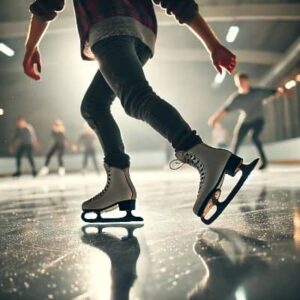
- Stay relaxed. The more smoothly you glide, the smoother your movements will be.
Do you know?
According to a study published in the Journal of Sports Science, balance plays a key role in ice skating performance. Regular practice with a focus on balance can improve your skating skills by as much as 30%. Practicing gliding frequently will improve both your balance and control on the ice.
Step 4: Advanced Techniques – Crossovers and Pivots
Once you’re comfortable, it’s time to move on to some advanced techniques.
Crossover:
This is where you put one foot on top of the other while skating backwards. This allows sharp turns and smooth transitions. Patrick Chan recommends concentrating on slow, controlled crossovers before gradually increasing your speed. Mastering this trick can greatly improve your agility on the ice.
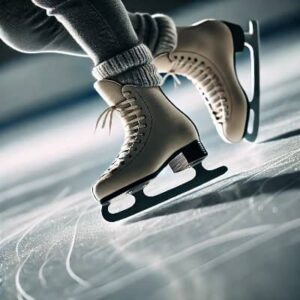
Pivot Turn:
To change direction while skating backwards, use a pivot turn. This move involves pushing off with one foot and pivoting with the other, allowing you to change direction effortlessly.
Pro Tip: Consistently practice these advanced techniques to improve your agility and control on the ice. Professional skaters around the world emphasize the importance of balance, accuracy and muscle memory in perfecting these tricks.
Common Mistakes (and How to Fix Them)
Let’s keep it real—skating backwards isn’t easy at first. You will make mistakes, and that’s okay. Here are some common mistakes and ways to fix them:
-
Leaning too far forward
Keep your chest up and your knees bent. Leaning forward can spoil your balance. What is the solution to this? Rest your body and trust your skates.
-
Look down at your feet
It’s tempting to check your feet’s movements, but looking downwards throws you off balance. Focus on where you’re going, not on your feet.
-
Going too fast too soon
Speed is not the goal here. Take your time until you feel under control. Experts suggest focusing on technique first—speed will come naturally.
How to stop while skating backwards
It may seem difficult to stop while skating backwards, but the best way is to use a plow stop:
- Bend your knees.
- Turn your toes slightly inward to form a “V” shape.
- Use the inside edges of your skates to push your heels outward to slow down the pace.
Safety Tip: Professional skaters recommend practicing this stop repeatedly to gain confidence, especially when learning on busy rinks. Wearing protective gear like a helmet and wrist guards can help you avoid injuries while you learn.
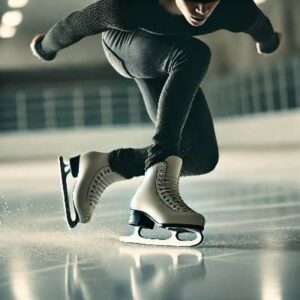
FAQ
-
How long does it take to learn to skate backwards?
For most people, it may take just a few hours of focused practice to learn the basics of skating backwards, but it may take a few weeks to master it. Skating coaches advise practicing 2-3 times a week for best results.
-
Is skating backwards more difficult than skating forwards?
Yes, it can be difficult because you rely more on balance and technique. However, once you get comfortable, skating backwards can feel just as natural as skating forwards. U.S. According to figure skating experts, skating backwards strengthens your overall skating skills and improves agility.
-
How can I improve my equilibrium?
Balance is critical to all skating techniques. Off-ice exercises such as core strengthening and balance exercises can help greatly. Studies conducted by sports scientists have shown that balance training improves ice skating performance by 30%.
-
How do I pick the right skates?
Visit IceSkatesHQ for a detailed guide on finding the right skates for your skill level and skating style. If you’re serious about progressing, investing in a good pair of skates makes a big difference. Look for models backed by professional skaters to ensure top-quality performance and durability.
-
Should I use protective gear while learning?
Absolutely! Wearing a helmet, knee pads and wrist guards can prevent serious injuries, especially for beginners. The safety gear gives you the confidence to practice more challenging techniques without fear of falling.
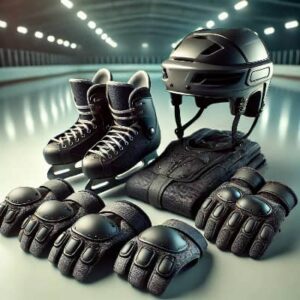
Conclusion
Learning to ice skate backwards requires patience and practice. Focus on your balance, starting with the basics and gradually incorporating advanced techniques like crossovers and pivots. You’ll be skating like a professional in no time!
For more expert tips, gear recommendations, and a detailed guide to improving your skills, don’t forget to check out IceSkatesHQ, a trusted resource for all things ice skating.

